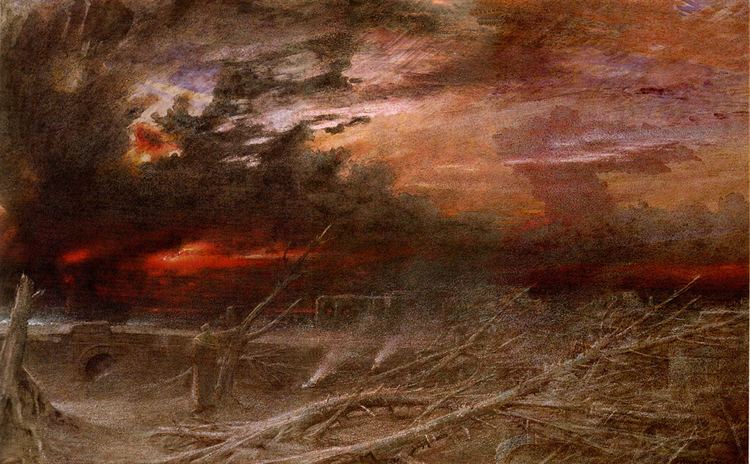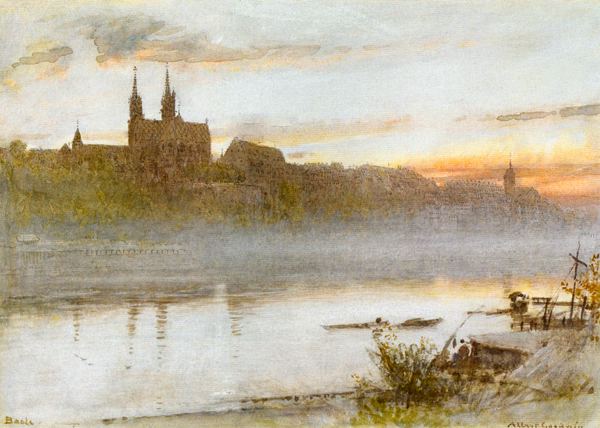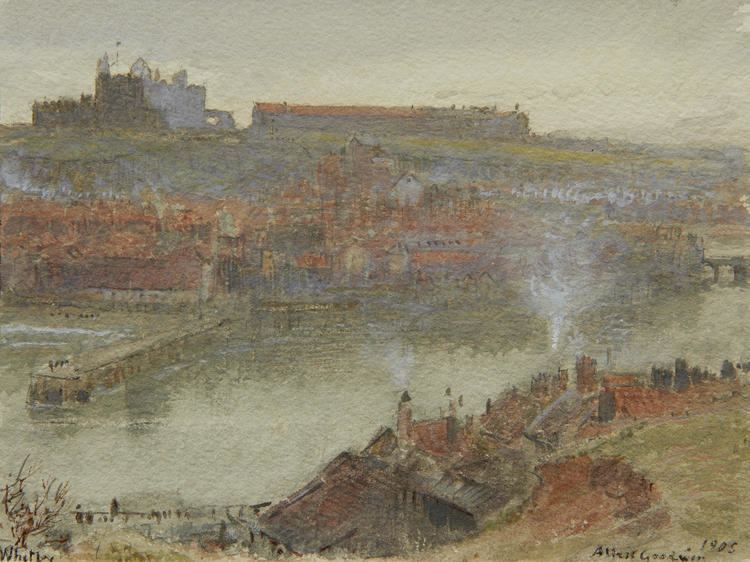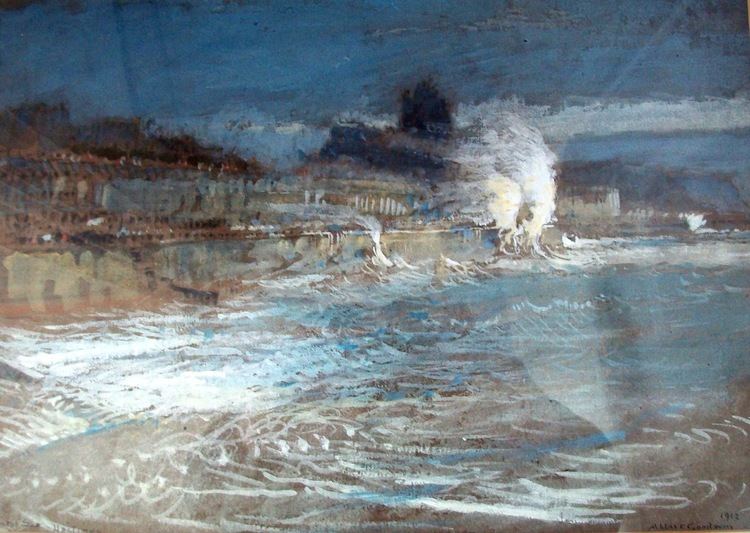Full Name Albert Goodwin Ethnicity English Canadian Monuments Memorial headstone Name Albert Goodwin | Nationality English Role Artist Other names Ginger Goodwin Died 1932 | |
 | ||
Cause of death Single gunshot/head trauma Resting place Cumberland cemetery49°38′15″N 125°00′24″W / 49.637485°N 125.006775°W / 49.637485; -125.006775 | ||
Pēteris Vasks - Voices Symphony for Strings (Symphonie für Streicher 'Stimmen')
Albert "Ginger" Goodwin (May 10, 1887 – July 27, 1918) of Treeton, England, affectionately named for his bright red hair, was a migrant coal miner who found work in the Cumberland mines, arriving on Vancouver Island in late 1910. Goodwin was disgruntled by the working conditions and management's ubiquitous disregard of all labour factions. Zealous for change, Goodwin became an advocate for workers rights, organizing and promoting the proliferation of trade unions. Goodwin increased in stature to become a highly prominent leader of the social movement that organized labour, but died rather suddenly under highly controversial circumstances that have not been settled to this day. The widely held belief was that Goodwin was murdered in an attempt to stifle collective bargaining; his death inspired the 1918 Vancouver general strike on August 2, 1918, Canada's first General Strike ever. This strike was a precursor to the Winnipeg General Strike of 1919, a defining moment in Canadian labour history.
Contents
- Pteris Vasks Voices Symphony for Strings Symphonie fr Streicher Stimmen
- Early life and radicalization
- Labour activism
- Death
- Legacy
- Quotes
- References

Early life and radicalization

Goodwin was born in Treeton, Yorkshire, England, and was a coal miner for most of his working life. Goodwin immigrated to Canada at the age of 19, and spent time working in Glace Bay, Nova Scotia. In 1910, Goodwin moved to the East Kootenay region of British Columbia. He moved a third time to Cumberland, to work for James Dunsmuir on Vancouver Island. Mayse's book Ginger: The Life and Death of Albert Goodwin says that Goodwin found the working conditions in the Cumberland mines to be "appalling". The lack of care regarding miners safety radicalized him. After only a year and half, he was swept up in the vicious Coal Miners' Strike on Vancouver Island, which began in Cumberland and lasted from September 1912 until the beginning of World War I in 1914. Although the strike did not garner favorable change for workers, it was regarded as an extreme economic burden on Canada. Goodwin emerged as a dedicated socialist and union leader. After the strike of 1912, he spoke out against the inhumane conditions miners were subject to. As a result of his vocal opposition, Goodwins role was noted by employers and he was subsequently blacklisted and never allowed to mine again.
Labour activism

In 1916, Goodwin moved to Trail, British Columbia, where he worked as a "smelterman" for the Consolidated Mining and Smelting Company of Canada Limited. He then entered politics and ran as a candidate of the Socialist Party of Canada in the 1916 provincial election. On December 18, 1916, Goodwin was elected "full-time secretary" of the Trail Mill and Smeltermen’s Union. The following year he was elected vice-president of the British Columbia Federation of Labour, and president of both the International Union of Mine, Mill, and Smelter Workers, District 6, and the Trail Trades and Labour Council.

Goodwin was a conscientious objector during World War I, openly stating that the working class were now being employed to kill each other in the war. Goodwin nevertheless complied with the law and signed up for the draft, but was not conscripted after a medical examination found him temporarily unfit for military duty, stating that as a result of working in the mines he suffered from "black lung" and bad teeth. Shortly thereafter, Goodwin led a strike at the Trail lead/zinc smelter in 1917, bargaining for a standard eight-hour workday. Amidst the strike, Goodwin was notified that his temporary status had been changed and that he was now "fit for duty".
Death

After he lost his appeals against conscription, Goodwin fled to the hills of Cumberland, joining other men who were evading conscription.Goodwin successfully hid for months without being captured. He was aided by sympathetic locals, who left food and provisions. Sometimes, the men hiding would break into cabins.
A group of men including a known cougar hunter joined Dan Campbell and scoured the mountains for the evaders. Campbell was a disgraced ex policeman from Esquimalt, British Columbia, who was acting as a Dominion Police Special Constable. Campbell was armed with a deer rifle.
It is unknown if Campbell and Goodwin approached each other, or if one man caught up with the other. Goodwin was shot in the neck and wrist. The shot through the neck severed Goodwins spinal chord. There were no witnesses.
Two undertakers refused a police request to bury Goodwin on the spot where he was shot. Instead, they hauled his body back to Cumberland using a fabric sling.
Goodwin's body was taken through the streets in a procession that was a mile long. He was interred at the Cumberland Municipal Cemetery.
A grand jury in Victoria, British Columbia dismissed the charges of manslaughter against Campbell, who claimed he fired in self-defence. Police officers and two justices of the peace felt there was enough evidence to warrant a proceeding.
The labour movement was outraged.
Legacy
Goodwin's death sparked the Vancouver general strike on August 2, 1918. It was Canada's first general strike.
The 1980s saw a revival of Goodwin's legacy in Cumberland with the start of Miners' Memorial Day in 1986. Organized by the Cumberland Museum and Archives, this annual event celebrates the memory of Cumberland's Miners, including the 295 who died in various mining accidents over the decades. A "graveside vigil" is also held every year, during which local unions and other organizations place fair-trade flowers at Goodwin's headstone. Goodwin is fondly remembered for giving his life for the right to organize.
In 1989, the mountain where Goodwin was shot was named "Mount Ginger Goodwin".
A section of Vancouver Island Highway 19 that passes through Cumberland was briefly named Ginger Goodwin Way in the 1990s. On Labour Day, 2001, the signs were quietly removed by the newly elected BC Liberal government. The signs' removal indicates the continuing controversy over Goodwin's death and legacy.
In 2015 the film "Goodwins Way" was filmed. The film documents the town of Cumberland, BC, resisting the opening of a new mine and resurrecting the legacy of Ginger Goodwin. Residents share their varied viewpoints on the story of the rebellious labour hero.
Quotes
"...we know that all this misery is the outcome of someone's carelessness, and that someone is the capitalists, those who own the machinery of production... This class of parasites have been living on the blood of the working class, they are responsible for the conditions existing at the present time... In order to throw this system over we have got to organize as a class and fight them as class against class... and our weapons are education, organization and agitation... and the principles of Socialism, for it is necessary that you know when to strike and how to strike, and if we have not these weapons when the time comes, we shall not be able to predict the outcome of the fight... we have the power and the lever to overthrow the existing society."
"War is simply part of the process of Capitalism. Big financial interests are playing the game.They'll reap the victory, no matter how the war ends."
